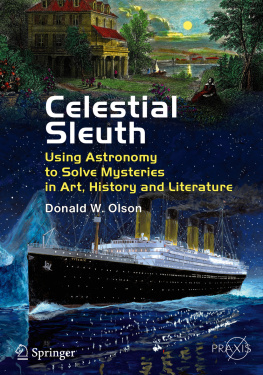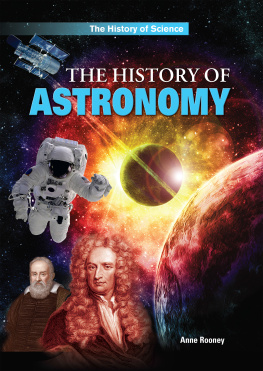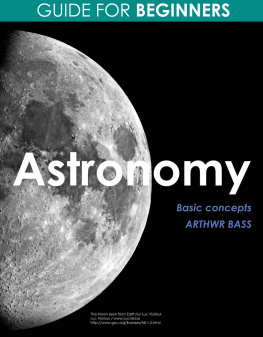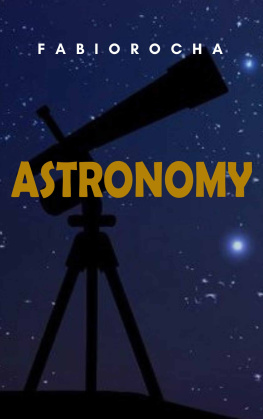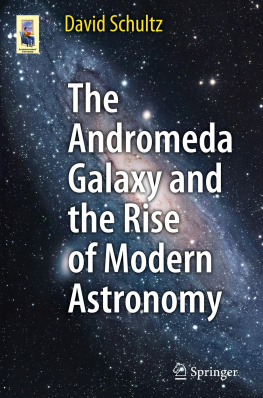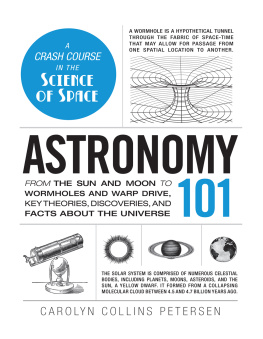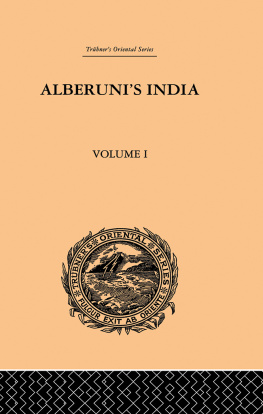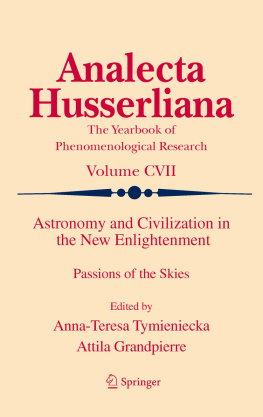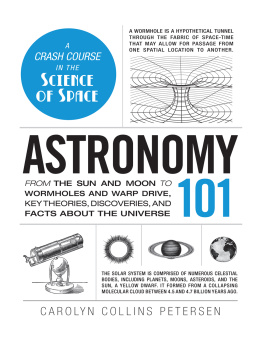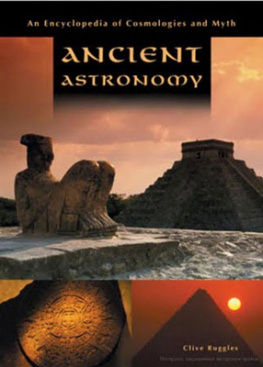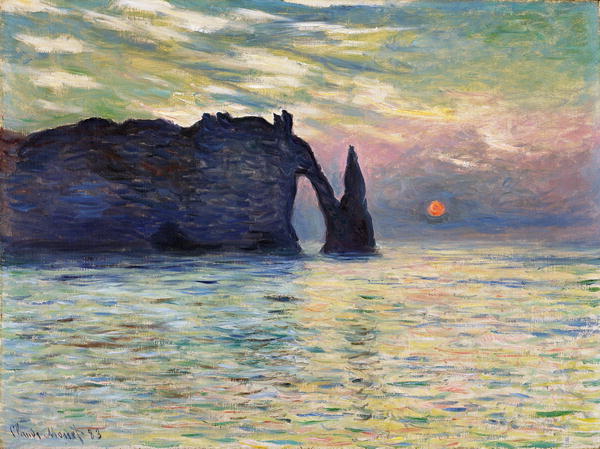Donald W. Olson Springer Praxis Books Celestial Sleuth 2014 Using Astronomy to Solve Mysteries in Art, History and Literature 10.1007/978-1-4614-8403-5_1
Springer Science+Business Media New York 2014
1. Monet and Turner, Masters of Sea and Sky
Abstract
Claude Monet, a founding member of the Impressionist movement, and Joseph Mallord William Turner, often described as Englands greatest painter, are both famous for spectacular landscapes accurately capturing the changing nature of skies and seas. Astronomical considerations of daylight, twilight, night skies, and tides can be used to enhance our understanding of the creative process for these artists. Monet painted a dramatic scene in his The Cliff, tretat, Sunset , created in 1883 at a popular resort on the Normandy coast. The canvas shows the orange disk of the Sun sinking toward the horizon near a spectacular line of cliffs and an arch called the Porte dAval. In the background, behind the arch, rises a pyramid-like rock formation called the Needle.
Claude Monet, a founding member of the Impressionist movement, and Joseph Mallord William Turner, often described as Englands greatest painter, are both famous for spectacular landscapes accurately capturing the changing nature of skies and seas. Astronomical considerations of daylight, twilight, night skies, and tides can be used to enhance our understanding of the creative process for these artists. Monet painted a dramatic scene in his The Cliff, tretat, Sunset , created in 1883 at a popular resort on the Normandy coast. The canvas shows the orange disk of the Sun sinking toward the horizon near a spectacular line of cliffs and an arch called the Porte dAval. In the background, behind the arch, rises a pyramid-like rock formation called the Needle.
More than a century later, can a modern visitor to tretat reach the spot where Monet set up his easel? Do the existing books and articles about Monet in Normandy direct visitors to the correct location? How can we determine Monets precise location, accurate to within a few feet? How do astronomical analyses, tide calculations, meteorological records, and the artists letters allow us to determine the exact date and the precise time, accurate to the minute, when Monet observed the sky that inspired this painting?
J. M. W. Turner in 1829 exhibited a watercolor depicting a stagecoach accident on a snowy mountain road in southeastern France, with a night sky overhead. Turner, who appears wearing a top hat in the foreground of the painting, was a passenger returning to England from a sojourn in Italy. The sky above the mountain includes the Moon and several bright stars or planets. On what date did this stagecoach accident occur? Did Turner paint the Moon in the appropriate lunar phase for that date? Can we identify the celestial bodies near the Moon? Are they stars or planets? Can we verify that Turners painting gives an accurate portrayal of the celestial scene?
Monets The Cliff, tretat, Sunset
Claude Monet (18401926) created almost 2,000 paintings during his long career. More than 80 of these works depict the spectacular cliffs, arches, rocks, and beaches near the town of tretat. The canvas entitled The Cliff, tretat, Sunset (Fig. ) shows a late afternoon sky on a winter day in 1883.
Fig. 1.1
The Cliff, tretat, Sunset , W817, Claude Monet, 1883. The position of the Sun, the level of the tides, Normandy weather observations, and Monets letters allow us to date this striking sunset scene to February 5, 1883, at 4:53 p.m. local mean time (North Carolina Museum of Art, Raleigh, purchased with funds from the State of North Carolina)
The town lies near the center of a crescent-shaped bay that faces out onto the English Channel. A cliff known as the Falaise dAmont forms the northeastern half of the crescent and includes, near its seaward end, a small arch called the Porte dAmont (upstream portal). To the southwest of the town is the cliff known as the Falaise dAval, with the impressive arch called the Porte dAval (downstream portal). Beyond this arch stands a tall pyramid-shaped rock called the Aiguille (Needle). Even farther to the southwest lie another bay and the Jambourg beach, accessible only at low tide. From the Jambourg beach, visitors can look back northeast to gain an entirely different perspective on the Porte dAmont and Needle, or they can look southwest to see an enormous arch called the Manneporte (great portal).
As a visitor walks along the curve of the central tretat beach, interesting changes take place in the way that the Porte dAval overlaps the more distant Needle. From viewing locations near the far southwestern end of the tretat beach, the Needle disappears from view, hidden behind the Aval cliff. As the person begins to walk along the beach to the northeast, the Needle first becomes partly visible through the Porte dAval arch. As seen from most of the beach near the center of the town, the Needle rises behind the Porte dAval. If a person continues past the town and walks northeast toward the Porte dAmont, eventually the Needle separates from the seaward end of the Aval arch. From viewpoints near the Porte dAmont, the entire Needle becomes visible as an impressive isolated pyramid rising from the waves.
As pointed out by art historian Robert Herbert, Monet shows all these views in his large series of tretat paintings (Herbert : 61). By looking at the topography, especially the way the Porte dAval arch overlaps the Needle in these canvases, we can determine the exact positions where Monet set up his easel.
Monets Painting Campaign in 1883
Monet arrived at the Hotel Blanquet in tretat on January 31, 1883. The artist created 18 works during a 3-week stay before departing on February 21st.
tretat , Sunset , created during this campaign and with the signature and date at the lower left Claude Monet 83, shows the disk of the setting Sun near the Porte dAval and the Needle. This canvas now resides in the permanent collection of the North Carolina Museum of Art, where curator David Steel has remarked on its unique quality: Monet painted several sunset views at tretat, but only this one actually shows the declining orb, a single, clockwise whorl of pigment set on top of the blue-gray horizon (Steel : 128).
William Fuller, an early owner of the painting, provided a vivid and enthusiastic text in a small catalog that he wrote to accompany an 1899 Monet exhibition at the Lotos Club in New York City:
The red sun is struggling through a bank of sullen clouds, apparently shorn of its power, as it slowly sinks to the horizon; but it still flings its radiance across the dome of the sky, from which are reflected the colors and the light that fall upon the restless, foam-covered waters below. In the middle distance, with its flying buttress and its half-submerged cathedral spire, grim in its solitude, stands the dark, impressive cliff of tretat. Unique in composition, splendid in color, suggestive in sentiment, Monet has painted in this picture one of the most transient as well as one of the most beautiful phases of the glory of the sky and sea. (Fuller : 17)
Daniel Wildenstein prepared a complete catalog of Monets works and letters in 1979, with a revised edition appearing in 1996. Ever since, art historians have identified each Monet canvas by its number in these Wildenstein catalogs. For example, this sunset painting is known as W817.

